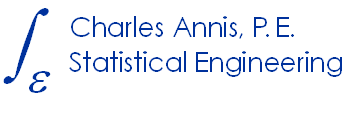Mathematical Formulation of the RFL Model:
Earlier attempts at modeling the stress-life (s-N) behavior of cyclic fatigue in the long life regime used a linear equation relating log(cycles) and log(stress), modified with a constant runout stress, or fatigue limit:
\[\log(N_i) = \beta_0 + \beta_1 \log(S_i – \beta_2)+ \epsilon_i \tag{1}\]
where, for specimen i, \(N_i\) represents cycles to failure, \(S_i\) is the applied stress parameter, and \(\beta_2\) is a constant fatigue limit \(S_i \gt \beta_2\), and \(\epsilon_ i\) is a random variable representing the scatter in cycles to failure about the predicted life.
Typically, the life random variable, \(\epsilon\), would be represented by a lognormal distribution with zero mean. For this assumption, \(\epsilon_i\) is the difference between the log life of specimen \(i\) and the log median life at the test stress \(S_i\). The parameters of the median life prediction, \(\beta_0, \beta_1,\) and \(\beta_2\) are estimated from test data and \(\beta_2\) is interpreted as the fatigue limit stress condition. Since \(\beta_2\) is an asymptote, the s-N curve flattens as \(S\) approaches the fatigue limit. This model is only marginally adequate for the median behavior in the long life regime but it is not consistent with the commonly observed increase in the standard deviation of lives as \(S\) approaches the constant fatigue limit (see Figure 1).
But the main shortcoming of a constant fatigue limit is that it doesn’t work. Since it is a single-valued constant, the fatigue limit, \(\beta_2\), must be less than the lowest stress tested (so that the logarithm of \((S_i – \beta_2)\) is defined) whether the specimen failed at that stress or not. This causes the \(\beta_2\) asymptote to be so low as to produce an unrealistic material model that had to be continually revised downward to accommodate newer, low stress data.
The random fatigue limit model is a generalization of Equation (1) in which the fatigue limit term is modeled as a random variable that can be considered to result from inherent, but unknown, quality characteristics of each specimen in the population. Thus the value of the fatigue limit is not a single constant, but rather an individual characteristic of each specimen (or component). The RFL model for test specimen i is given by:
\(\log(N_i) = \beta_0 + \beta_1 \log (S_i -\gamma_i ) + \epsilon_i \tag{2}\)
where \(\gamma_i\) is the random fatigue limit for specimen i \((S_i \gt \gamma_i)\) and is expressed in units of the stress parameter.
\(\leftarrow\) RFL – Impetus
The RFL model produces probabilistic s-N curves that have the characteristics commonly seen in HCF data. This is illustrated in Figure 1 which presents the 1st, 5th, 10th, 50th, 90th 95th and 99th percentile s-N curves as would be determined from the distribution of fatigue limits. The percentile s-N curves display the commonly observed shape in the HCF regime. Further, it is easily seen in Figure 1 that a difference in test lives from two specimens with slightly different fatigue limits could be quite large. The increased scatter in fatigue lives is explained by different specimens having different fatigue limits and this is true regardless of the scatter in life at higher stresses. Thus, the RFL model accommodates not only the flattening of the s-N curve but also the increased scatter that is typical of HCF lives.
Experience indicates that the fatigue limit scatter dominates in the HCF regime when \(S\) is close to \(\gamma_i\) while the scatter in life is more significant when \(S\) is large compared to \(\gamma_i\).
There are two random variables in the RFL model for which probability distributions are needed. Experience again suggests the conventional lognormal distribution is appropriate for \(\epsilon_i\), the scatter in cyclic lives. Thus, the conditional distribution of cycles to failure given \(\gamma_i\) will be a lognormal distribution with mean equal to \(\beta_0 + \beta_1 \log (S_i -\gamma_i )\) and standard deviation equal to \(\sigma_{\epsilon}\). Then \(\epsilon\) is lognormal \((0, \sigma_{\epsilon})\).
The Weibull distribution does well describing the skewed downward behavior of the random fatigue limit, \(\gamma\). The Weibull parameters, \(\eta, \beta_0\), represent the 63.2th percentile runout stress, and shape parameter, respectively. Thus \(\eta\) has the same units as the stress metric. Specimens will have inherent, but unknown, quality differences that result in distinct fatigue resistance in the long life regime. The upper limit of runout stress is observed to be more restrictive than the lower limit. That is, while a very low quality specimen is sometimes observed, albeit infrequently, extremely high runout stresses are never observed. (And it is these infrequent lower performers that are at the crux of the HCF problem.) The RFL model provides a means to measure the propensity for this life-limiting behavior.

